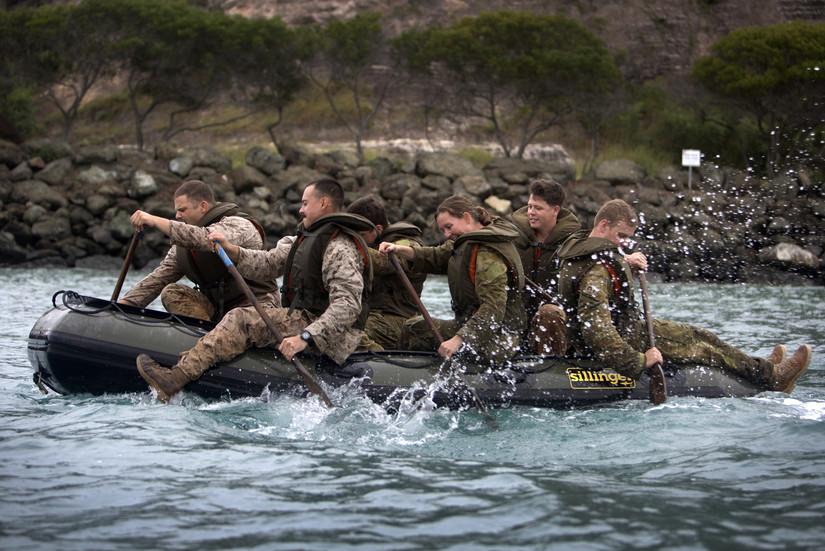
In recent weeks a lively debate has swirled around Hugh White’s canvassing of a possible indigenous nuclear-weapon program in Australia’s future—or, more accurately, in that version of Australia’s future where the US presence in Asia and extended nuclear deterrence have collapsed and Australia, ‘home alone’, is attempting to defend itself against a hostile, powerful China. In this post, I want to transplant that scenario to the broader regional framework and unpack some preliminary thoughts about what Australian strategy—as opposed to Australian defence—might look like.
As I’ve observed in a previous post, the failure of US extended nuclear deterrence would result in a profound imbalance of residual nuclear capabilities in Asia. The remaining nuclear powers would be—in order of arsenal size—Russia, China, Pakistan, India and North Korea. (Russia’s arsenal is currently measured in the thousands, China’s in the hundreds, Pakistan’s at about 140 warheads, India’s at perhaps 120 warheads, and North Korea’s at roughly 40–70 warheads.) Only one of the five is a democracy and it has the second smallest nuclear arsenal and a strategic doctrine that still bears the marked imprint of non-alignment. Even without a single warhead being fired in anger, the gravitational effects of that imbalance would be felt—intolerably—across the region.
Now, that’s the scenario which underpins the current debate over whether Australia might reconsider its nuclear options. But, so far, much of our debate has centred too narrowly on our immediate defence needs and on whether we even have the capabilities to build nuclear weapons anyway. There’s a much bigger question that arises, and it’s one that concerns a range of regional countries and not merely Australia. Isn’t this a situation where a—measured—cascade of proliferation would enhance regional stability rather than undermine it?
If we judged that rectifying the regional nuclear imbalance was important to us, we’d see our policy options in a different light. Australian proliferation would probably be part of the rectification, but a small and slow part. By ourselves, it would take decades to build a credible arsenal. And geography still wouldn’t be our friend—the brutal truth, which in many ways is a virtue for Australian security too, is that Australia stands too far back from the critical force balances along the Eurasian rimlands to be seen as a central player. In short, regional stability would continue to turn primarily upon balances other than the China–Australia one.
So, might we see nuclear-weapon programs unfold elsewhere across the region? Yes. And we shouldn’t expect them to look like the proliferation efforts of the past, which were typically national-centric efforts. The nuclear-weapon states the world has now are—broadly—great powers and rogues. Great powers needed little help to proliferate; rogues attracted little help to proliferate. But we shouldn’t automatically expect status quo middle powers, driven by a sudden imperative to proliferate, to behave the same way. ‘Sociable’ proliferation, where partners work together to obtain nuclear capabilities, is much more likely—particularly if those middle powers share a set of strategic interests that they see as stabilising and regionally beneficial. Thus we might see both a new, cooperative model of proliferation and a different region emerge at the same time.
Of course, sociable proliferation would still mean the end of the Nuclear Non-Proliferation Treaty. A range of status quo states would have to leave the treaty, and they’d probably be leaving not one by one but two by two. Their doing so would, in all probability, collapse the tent. After all, Asia’s not the only region where a sudden cascade of proliferation might make sense. Nuclear-weapon programs would likely spring up elsewhere—in both the Middle East and Europe, for example—whether Asia acted or not. Some would succeed, some would fail; not all countries are well placed to proliferate sociably.
But let’s wrench the argument back closer to home. Would there be a case for Australia to do more to support rectification of the nuclear imbalance in Asia and, if so, what should we be doing? (Just as a forewarning, readers should remember that the following recommendations are scenario-dependent—they are not designed for the world we live in now, or even for the world most likely to come into being.)
Since the fundamentals of Australian security are set at the Eurasian rimlands, yes, Australia should be doing more to correct the nuclear imbalance the scenario depicts. We might do so, timidly, by signalling our understanding of other countries’ proliferation efforts in cases which we saw as regionally stabilising. Signalling is cheap but not especially sociable. More practically, we might consider a range of supportive or cooperative linkages to other countries’ efforts. At the other end of the spectrum from supportive signalling are actual joint proliferation programs where countries share both the burdens and the rewards of proliferation.
Northeast Asian countries are generally further down the track in terms of nuclear latency than their Southeast Asian counterparts. So we would be talking a lot more to Japan and South Korea about shared interests and prospects for cooperation. Within Southeast Asia, we would probably be canvassing with Indonesia and Vietnam the opportunities to enhance bilateral or even trilateral cooperation. And we would likely be talking to New Delhi about how Australia could help India strengthen its position on the regional nuclear ladder.
Thinking about Hugh White’s scenario in its strategic dimensions highlights just what a different world that might yet turn out to be. Big questions would confront Australia—and none of them would have simple, rules-based answers. But the big questions would likely reinforce our core strategic principle: that partnerships have been the basis of real Australian leverage in the world and we should work with others, not alone, even in the hard area of proliferation.